 W
WThe Aberdeen Bestiary is a 12th-century English illuminated manuscript bestiary that was first listed in 1542 in the inventory of the Old Royal Library at the Palace of Westminster. Due to similarities, it is often considered to be the "sister" manuscript of the Ashmole Bestiary. The connection between the ancient Greek didactic text Physiologus and similar bestiary manuscripts is also often noted. Information about the manuscripts origins and patrons are circumstantial, although the manuscript most likely originated from the 13th century and was owned by a wealthy ecclesiastical patron from north or south England. Currently, the Aberdeen Bestiary resides in the Aberdeen Library in Scotland.
 W
WAlmost like a Whale by Steve Jones is a modern introduction to Charles Darwin's Origin of Species and closely follows its structure. It won the 1999 BP Natural World Book Prize.
 W
WThe Ancestor's Tale: A Pilgrimage to the Dawn of Life is a science book by Richard Dawkins and Yan Wong on the subject of evolution, which follows the path of humans backwards through evolutionary history, describing some of humanity's cousins as they converge on their common ancestors. It was first published in 2004 and substantially updated in 2016.
 W
WBiochemistry is a common university textbook used for teaching of biochemistry. It was initially written by Lubert Stryer and published by W. H. Freeman in 1975. It has been published in regular editions since. It is commonly used as an undergraduate teaching textbook or reference work.
 W
WBiology Today is a college-level biology textbook that went through three editions in 1972, 1975, and 1980. The first edition, published by Communications Research Machines, Inc. (CRM) and written by a small editorial team and large set of prominent "contributing consultants", is notable for its lavish illustrations and its humanistic approach. It was significantly rewritten by David L. Kirk and others for the second and third editions, which were issued by Random House.
 W
WBiology Today: An Issues Approach is a college-oriented Biology textbook by Eli C. Minkoff and Pamela J. Baker designed to integrate the teaching of biological concepts within the context of current societal issues relating to these topics. It is the original issues-oriented introductory-level general biology textbook. The latest edition is currently published by the textbooks division of Garland Science. It is 768 pages long.
 W
WThe Body Electric: Electromagnetism and the Foundation of Life is a book by Robert O. Becker and Gary Selden in which Becker, an orthopedic surgeon at SUNY Upstate working for the Veterans Administration, described his research into "our bioelectric selves".
 W
WBrain Gender is a book by Melissa Hines, Hines graduated with an undergraduate degree from Princeton, following through with a doctorate in psychology from UCLA. Currently, Hines is a psychologist and neuroscientist at the University of Cambridge.
 W
WThe Canon: A Whirligig Tour of the Beautiful Basics of Science is a book written by American science author Natalie Angier.
 W
WClose to Shore: A True Story of Terror in an Age of Innocence is a non-fiction book by journalist Michael Capuzzo about the Jersey Shore shark attacks of 1916. The book was published in 2001 by Broadway Books.
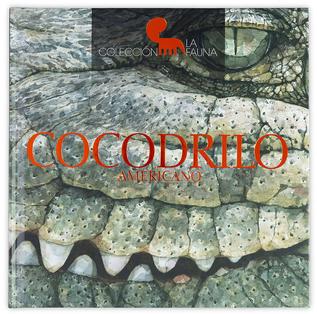 W
WColección La Fauna, is a series of books about the Fauna of Venezuela.
 W
WDemonic Males: Apes and the Origins of Human Violence is a 1997 book by Richard Wrangham and Dale Peterson examining the evolutionary factors leading to human male violence.
 W
WThe Devil's Teeth: A True Story of Obsession and Survival Among America's Great White Sharks is a non-fiction book about great white sharks by American journalist Susan Casey. The text was initially published by Henry Holt and Company on June 7, 2005. The book became a widely acclaimed bestseller.
 W
WThe Dialectical Biologist is a 1985 book by the ecologist Richard Levins and the biologist Richard Lewontin, in which the authors sketch a dialectical approach to biology. They see "dialectics" more as a set of questions to ask about biological research, a weapon against dogmatism, than as a set of pre-determined answers.
 W
WDNA Repair and Mutagenesis is a college-level textbook about DNA repair and mutagenesis written by Errol Friedberg, Graham Walker, Wolfram Siede, Richard D. Wood, and Roger Schultz. In its second edition as of 2009, DNA Repair and Mutagenesis contains over 1,000 pages, 10,000 references and 700 illustrations and has been described as "the most comprehensive book available in [the] field."
 W
WThe Double Helix: A Personal Account of the Discovery of the Structure of DNA is an autobiographical account of the discovery of the double helix structure of DNA written by James D. Watson and published in 1968. It has earned both critical and public praise, along with continuing controversy about credit for the Nobel award and attitudes towards female scientists at the time of the discovery.
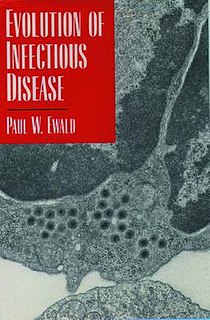 W
WEvolution of Infectious Disease is a 1993 book by the evolutionary biologist Paul W. Ewald. In this book Ewald contests the traditional view that parasites should evolve toward benign coexistence with their hosts. He draws on various studies which contradict this dogma and asserts his own theory that is based on fundamental evolutionary principles. This book provides one of the first in-depth presentations of insights from evolutionary biology on various fields in health science, including epidemiology and medicine.
 W
WEvolutionary Biology is a college-level evolutionary biology textbook written by Eli C. Minkoff that is 627 pages long. It was published in 1983 by Addison-Wesley. This is Minkoff's first foray into the world of college-level textbook authorship. The book contains an index and various biographical references.
 W
WThe Facts of Life is a book published in 1953 by C. D. Darlington of the subject of race, heredity and evolution. Darlington was a major contributor to the field of genetics around the time of the Modern synthesis.
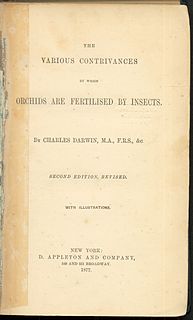 W
WFertilisation of Orchids is a book by English naturalist Charles Darwin published on 15 May 1862 under the full explanatory title On the Various Contrivances by Which British and Foreign Orchids Are Fertilised by Insects, and On the Good Effects of Intercrossing. Darwin's previous book, On the Origin of Species, had briefly mentioned evolutionary interactions between insects and the plants they fertilised, and this new idea was explored in detail. Field studies and practical scientific investigations that were initially a recreation for Darwin—a relief from the drudgery of writing—developed into enjoyable and challenging experiments. Aided in his work by his family, friends, and a wide circle of correspondents across Britain and worldwide, Darwin tapped into the contemporary vogue for growing exotic orchids.
 W
WFields Virology is an English-language virology textbook, published in two volumes, originally edited by Bernard N. Fields. The first edition in 1985 was called Virology, but the book's title was changed from the second edition to Fields Virology. The book is widely regarded as an influential work on the subject and is cited as the bible of virology by many virologists.
 W
WFigments of Reality: The Evolution of the Curious Mind (1997) is a book about the evolution of the intelligent and conscious human mind by biologist Jack Cohen and mathematician Ian Stewart.
 W
WFundamentals of Biochemistry: Life at the Molecular Level is a biochemistry textbook written by Donald Voet, Judith G. Voet and Charlotte W. Pratt. Published by John Wiley & Sons, it is a common undergraduate biochemistry textbook.
 W
WGod-Apes and Fossil Men is a book on paleoanthropology in the Indian Subcontinent by Kenneth A.R. Kennedy. The book is a detailed study of the history of Indian paleoanthropology and of the fossil record of prehistoric people of the Indian Subcontinent.
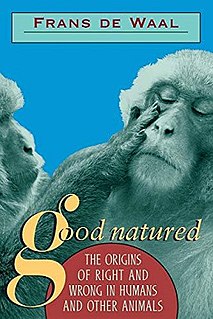 W
WGood Natured is a book by primatologist Frans de Waal on animal behavior and the evolution of ethics.
 W
WGulp: Adventures on the Alimentary Canal is a nonfiction work by the science author Mary Roach, published in April 2013 by W.W. Norton & Company.
 W
WHow the Snake Lost Its Legs: Curious Tales from the Frontier of Evo-Devo is a 2014 book on evolutionary developmental biology by Lewis I. Held, Jr. The title pays homage to Rudyard Kipling's Just So Stories, but the "tales" are strictly scientific, explaining how a wide range of animal features evolved, in molecular detail. The book has been admired by other biologists as both accurate and accessible.
 W
WKunstformen der Natur is a book of lithographic and halftone prints by German biologist Ernst Haeckel.
 W
WLes Vélins du Roi is a compendium of 6984 plant and animal paintings started in 1631 to document specimens from the royal garden and animal collection. Foremost illustrators such as Nicolas Robert, Pancrace Bessa, Gerard van Spaendonck, Claude Aubriet and Madeleine Françoise Basseporte contributed to the codex through the reigns of Louis XIII, Louis XIV and Louis XV, and the codex was finally entrusted in 1793 to the Museum Nationale d’Histoire Naturelle, where it remains.
 W
WThe Mathematics of Life is a 2011 popular science book by mathematician Ian Stewart, on the increasing role of mathematics in biology.
 W
WMen, Microscopes, and Living Things is a children's book written by the American author Katherine Shippen and illustrated by Anthony Ravielli. The book was first published in 1955 and is a 1956 Newbery Honor recipient.
 W
WMicrographia: or Some Physiological Descriptions of Minute Bodies Made by Magnifying Glasses. With Observations and Inquiries Thereupon. is a historically significant book by Robert Hooke about his observations through various lenses. It is particularly notable for being the first book to illustrate insects, plants etc. as seen through microscopes. Published in January 1665, the first major publication of the Royal Society, it became the first scientific best-seller, inspiring a wide public interest in the new science of microscopy. It is also notable for coining the biological term cell.
 W
WThe Mismeasure of Man is a 1981 book by paleontologist Stephen Jay Gould. The book is both a history and critique of the statistical methods and cultural motivations underlying biological determinism, the belief that “the social and economic differences between human groups—primarily races, classes, and sexes—arise from inherited, inborn distinctions and that society, in this sense, is an accurate reflection of biology”.
 W
WMolecular Biology of the Cell is a cellular and molecular biology textbook published by W.W. Norton & Co and currently authored by Bruce Alberts, Alexander D. Johnson, Julian Lewis, David Morgan, Martin Raff, Keith Roberts and Peter Walter. The book was first published in 1983 by Garland Science and is now in its sixth edition. The molecular biologist James Watson contributed to the first three editions.
 W
WMonad to Man: the concept of progress in evolutionary biology is a 1996 book about the longstanding idea that evolution is progressive by the philosopher of biology Michael Ruse. It analyses the connection between ideas of progress in culture generally and its application in evolutionary biology.
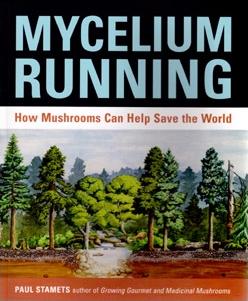 W
WMycelium Running: How Mushrooms Can Help Save the World is the sixth book written by American mycologist Paul Stamets.
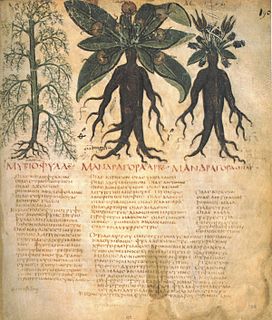 W
WThe Naples Dioscurides, in the Biblioteca Nazionale, Naples, is an early 7th-century secular illuminated manuscript Greek herbal. The book has 172 folios and a page size of 29.7 x 14 cm and the text is a redaction of De Materia Medica by the 1st century Greek military physician Dioscorides, with descriptions of plants and their medicinal uses. Unlike De Materia Medica, the text is arranged alphabetically by plant.
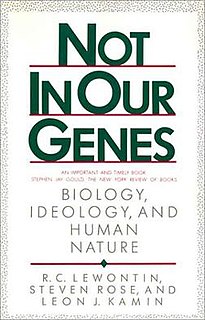 W
WNot in Our Genes: Biology, Ideology and Human Nature is a 1984 book by the evolutionary geneticist Richard Lewontin, the neurobiologist Steven Rose, and the psychologist Leon Kamin, in which the authors criticize sociobiology and genetic determinism and advocate a socialist society.
 W
WOf Moths and Men is a book by journalist Judith Hooper about the Oxford University ecological genetics school led by E.B. Ford. The book specifically concerns Bernard Kettlewell's experiments on the peppered moth which were intended as experimental validation of evolution. She highlights concerns about the methodology of Kettlewell's experiments and suggests that these issues could invalidate the results obtained, ignoring or disparaging evidence supporting natural selection while repeatedly implying that Kettlewell and his colleagues committed fraud or made careless errors. Subject matter experts have described the book as presenting a "conspiracy theory" with "errors, misrepresentations, misinterpretations and falsehoods".
 W
WOn Human Nature is a book by the biologist E. O. Wilson, in which the author attempts to explain human nature and society through sociobiology. Wilson argues that evolution has left its traces on characteristics such as generosity, self-sacrifice, worship and the use of sex for pleasure, and proposes a sociobiological explanation of homosexuality. He attempts to complete the Darwinian revolution by bringing biological thought into social sciences and humanities. Wilson describes On Human Nature as a sequel to his earlier books The Insect Societies (1971) and Sociobiology: The New Synthesis (1975).
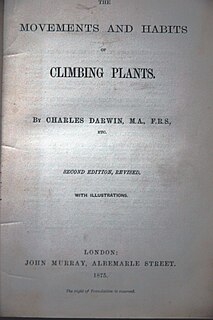 W
WOn the Movements and Habits of Climbing Plants is a book by Charles Darwin first printed in book form in 1875 by John Murray. Originally, the text appeared as essay in the 9th volume of the Journal of the Linnean Society, therefore the first edition in book form is actually called the ‘second edition, revised.’ Illustrations were drawn by Charles Darwin’s son, George Darwin.
 W
WOxford Dictionary of Biology is a multiple editions dictionary published by the English Oxford University Press. With more than 5,500 entries, it contains comprehensive information in English on topics relating to biology, biophysics, and biochemistry. The first edition was published in 1985 as A Concise Dictionary of Biology. The seventh edition, A Dictionary of Biology, was published in 2015 and it was edited by Robert Hine and Elizabeth Martin.
 W
WParasite Rex: Inside the Bizarre World of Nature's Most Dangerous Creatures is a nonfiction book by Carl Zimmer that was published by Free Press in 2000. The book discusses the history of parasites on Earth and how the field and study of parasitology formed, along with a look at the most dangerous parasites ever found in nature. A special paperback edition was released in March 2011 for the tenth anniversary of the book's publishing, including a new epilogue written by Zimmer. Signed bookplates were also given to fans that sent in a photo of themselves with a copy of the special edition.
 W
WPatterns of Sexual Behavior is a 1951 book by anthropologist Clellan S. Ford and ethologist Frank A. Beach, in which the authors integrate information about human sexual behavior from different cultures, and include detailed comparisons across animal species, with particular emphasis on primates. The book received positive reviews and has been called a classic. It provided the foundation for the later research of Masters and Johnson. A revised edition, titled Human Sexuality in Four Perspectives, was published in 1977.
 W
WPhycologia Australica, written by William Henry Harvey, is one of the most important works on phycology of the 19th century.
 W
WThe Physiologus is a didactic Christian text written or compiled in Greek by an unknown author, in Alexandria; its composition has been traditionally dated to the 2nd century AD by readers who saw parallels with writings of Clement of Alexandria, who is asserted to have known the text, though Alan Scott has made a case for a date at the end of the 3rd or in the 4th century. The Physiologus consists of descriptions of animals, birds, and fantastic creatures, sometimes stones and plants, provided with moral content. Each animal is described, and an anecdote follows, from which the moral and symbolic qualities of the animal are derived. Manuscripts are often, but not always, given illustrations, often lavish.
 W
WQuantum Aspects of Life, a book published in 2008 with a foreword by Roger Penrose, explores the open question of the role of quantum mechanics at molecular scales of relevance to biology. The book contains chapters written by various world-experts from a 2003 symposium and includes two debates from 2003 to 2004; giving rise to a mix of both sceptical and sympathetic viewpoints. The book addresses questions of quantum physics, biophysics, nanoscience, quantum chemistry, mathematical biology, complexity theory, and philosophy that are inspired by the 1944 seminal book What Is Life? by Erwin Schrödinger.
 W
WRace: The Reality of Human Differences is an anthropology book, in which authors Vincent M. Sarich, Emeritus Professor of Anthropology at the University of California, Berkeley, and Frank Miele, senior editor of Skeptic Magazine, argue for the reality of race. The book was published by Basic Books in 2004. It disputes the statements of the PBS documentary Race: The Power of an Illusion aired in 2003.
 W
WThe Science of Life is a book written by H. G. Wells, Julian Huxley and G. P. Wells, published in three volumes by The Waverley Publishing Company Ltd in 1929–30, giving a popular account of all major aspects of biology as known in the 1920s. It has been called "the first modern textbook of biology" and "the best popular introduction to the biological sciences". Wells's most recent biographer notes that The Science of Life "is not quite as dated as one might suppose".
 W
WThe Sea Around Us is a prize-winning and best-selling book by the American marine biologist Rachel Carson, first published as a whole by Oxford University Press in 1951. It reveals the science and poetry of the sea while ranging from its primeval beginnings to the latest scientific probings. Often described as "poetic," it was Carson's second published book and the one that launched her into the public eye and a second career as a writer and conservationist; in retrospect it is counted the second book of her so-called sea trilogy.
 W
WStiff: The Curious Lives of Human Cadavers is a 2003 non-fiction work by Mary Roach. Published by W. W. Norton & Company, it details the unique scientific contributions of the deceased.
 W
WThe Structure and Distribution of Coral Reefs, Being the first part of the geology of the voyage of the Beagle, under the command of Capt. Fitzroy, R.N. during the years 1832 to 1836, was published in 1842 as Charles Darwin's first monograph, and set out his theory of the formation of coral reefs and atolls. He conceived of the idea during the voyage of the Beagle while still in South America, before he had seen a coral island, and wrote it out as HMS Beagle crossed the Pacific Ocean, completing his draft by November 1835. At the time there was great scientific interest in the way that coral reefs formed, and Captain Robert FitzRoy's orders from the Admiralty included the investigation of an atoll as an important scientific aim of the voyage. FitzRoy chose to survey the Keeling Islands in the Indian Ocean. The results supported Darwin's theory that the various types of coral reefs and atolls could be explained by uplift and subsidence of vast areas of the Earth's crust under the oceans.
 W
WPeter Wohlleben is a German forester and author who writes on ecological themes in popular language. After graduation from forestry school in Rottenburg am Neckar, he took up a job as a government wood ranger in the Rhineland-Palatinate in 1987. As he grew more familiar with the woodlands he was overseeing, he became disenchanted due to the damage caused by the techniques and technologies he was expected to employ, including the felling of mature trees and the use of insecticides.
 W
WTwelve Days of Terror: A Definitive Investigation of the 1916 New Jersey Shark Attacks is a non-fiction book by Richard G. Fernicola about the Jersey Shore shark attacks of 1916. The book was published in 2001 by Lyons Press.
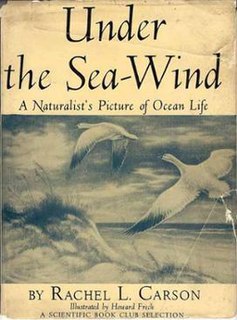 W
WUnder the Sea Wind: A Naturalist's Picture of Ocean Life (1941) is the first book written by the American marine biologist Rachel Carson. Her book was published by Simon & Schuster in 1941; it received very good reviews, but sold poorly. After the great success of a sequel The Sea Around Us, it was reissued by Oxford University Press; that edition was an alternate Book-of-the-Month Club selection and became another bestseller, and never gone out of print. It is recognized today as one of the "definitive works of American nature writing," and is in print as one of the Penguin Nature Classics.
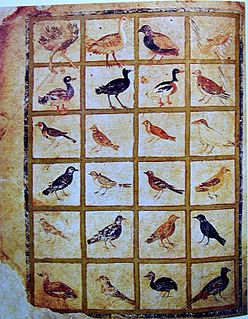 W
WThe Vienna Dioscurides or Vienna Dioscorides is an early 6th-century Byzantine Greek illuminated manuscript of De Materia Medica by Dioscorides in uncial script. It is an important and rare example of a late antique scientific text. The 491 vellum folios measure 37 by 30 cm and contain more than 400 pictures of animals and plants, most done in a naturalistic style. In addition to the text by Dioscorides, the manuscript has appended to it the Carmen de herbis attributed to Rufus, a paraphrase of an ornithological treatise by a certain Dionysius, usually identified with Dionysius of Philadelphia, and a paraphrase of Nicander's treatise on the treatment of snake bites.
 W
WThe Voyage of the Beagle is the title most commonly given to the book written by Charles Darwin and published in 1839 as his Journal and Remarks, bringing him considerable fame and respect. This was the third volume of The Narrative of the Voyages of H.M. Ships Adventure and Beagle, the other volumes of which were written or edited by the commanders of the ships. Journal and Remarks covers Darwin's part in the second survey expedition of the ship HMS Beagle. Due to the popularity of Darwin's account, the publisher reissued it later in 1839 as Darwin's Journal of Researches, and the revised second edition published in 1845 used this title. A republication of the book in 1905 introduced the title The Voyage of the "Beagle", by which it is now best known.
 W
W"What Is Life" is a song by the English musician George Harrison, released on his 1970 triple album All Things Must Pass. In many countries, it was issued as the second single from the album, in February 1971, becoming a top-ten hit in the United States, Canada and elsewhere, and topping singles charts in Australia and Switzerland. In the United Kingdom, "What Is Life" appeared as the B-side to "My Sweet Lord", which was the best-selling single there of 1971. Harrison's backing musicians on the song include Eric Clapton and the entire Delaney & Bonnie and Friends band, with whom he had toured during the final months of the Beatles. Harrison co-produced the recording with Phil Spector, whose Wall of Sound production also employed a prominent string arrangement by John Barham and multiple acoustic rhythm guitars, played by Harrison's fellow Apple Records signings Badfinger.
 W
WWhy Is Sex Fun? The Evolution of Human Sexuality is a 1997 book about the evolution of human sexuality by the biologist Jared Diamond.